|
Location: Mainland
Orkneys, Scotland. |
Grid Reference:
58� 59' 52" N.
3� 12' 48" W |
 The
'Ness' of Brodgar: The
'Ness' of Brodgar:
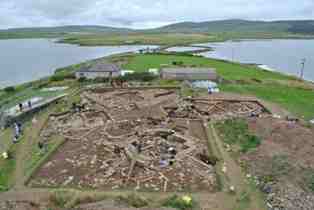 The Ness of Brodgar has been revealed as an
integral part of the Brodgar/Stennes Complex, being sited directly
between the two sites, and composing a complex of around 100
buildings and a vast wall, 100m long and 4m wide, traversing the
width of the peninsula and potentially surrounding the site
turning it into the equivalent of a a temple precinct.
(2) This site has greatly
helped to unravel the prehistoric perspective of the area. The
site It was occupied from 3,500 BC for over a thousand years,
showing stark similarities with Stonehenge. The archaeologist,
Mike Pearson who conducted the recent digs at Stonehenge has
suggested that the two sites may have similarities in function,
representing the symbolic boundary between the land of the
living and the land of the dead. The Ness of Brodgar has been revealed as an
integral part of the Brodgar/Stennes Complex, being sited directly
between the two sites, and composing a complex of around 100
buildings and a vast wall, 100m long and 4m wide, traversing the
width of the peninsula and potentially surrounding the site
turning it into the equivalent of a a temple precinct.
(2) This site has greatly
helped to unravel the prehistoric perspective of the area. The
site It was occupied from 3,500 BC for over a thousand years,
showing stark similarities with Stonehenge. The archaeologist,
Mike Pearson who conducted the recent digs at Stonehenge has
suggested that the two sites may have similarities in function,
representing the symbolic boundary between the land of the
living and the land of the dead.
Photo Credits:
http://www.ruralgateway.org.uk/node/3261
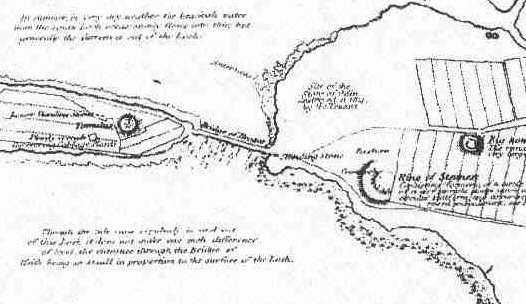
Archaeological
remains have been known on the site for over a hundred years as this
map of 1886 shows.
(Photo Credits:
http://www.megalithic.co.uk)
It is now
realised that the site is composed of as many as 100 structures
within the walled enclosure. Within these walls certain larger buildings, or structures
are being particularly noted by archaeologists:
Structure 1:
This building has
three doorways and three hearths. One of the doorways appears to
require its user to step over a hearth.
Structure 8:
A long building with a doorway at one end and three hearths
along the middle. Inside, the side walls are divided into
compartments by larger piers built into the walls. The building contained several broken mace
heads and some whale bone.
Structure 12:
Curiously, this building
has no hearths, the same piers,
and a narrow entrance at one end.
Structure 10: ('The
Cathedral') This building was
built over other buildings within the walls and is therefore
considerably younger. It�s roughly square,
has immensely thick walls enclosing a small central room and is
surrounded by a large amount of cattle bone.
The Great Wall of Brodgar.
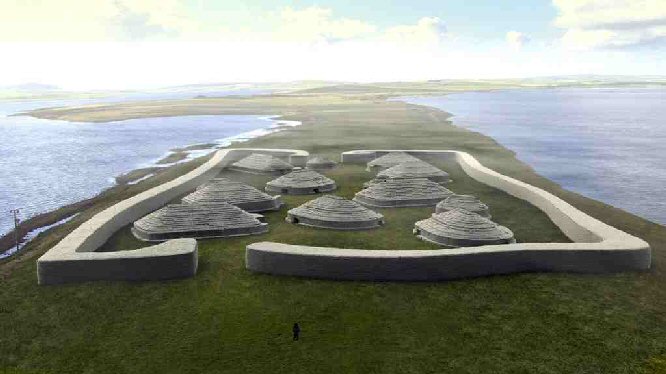
Photo Credits: (Will
MacNeil)
The wall is
suggested to have surrounded the complex almost entirely. It is the
result of a fantastic amount of man-hours, being 4m wide along its
length. It acts as a view-obscuring barrier with the most beautiful stonework
incorporated into the side facing the Ring itself. It is believed
that it was not intended as a defensive structure, but was more of a
symbolic barrier,
separating the activity on the south-east of the Ness from whatever
activity was going on around the
Ring of Brodgar.
The wall�s discovery fits in with a theory proposed a few years
ago that the two stone rings had specific roles in
Neolithic life � in particular representing life and death. This was first proposed by archaeologist Mike Parker Pearson in a
paper presented at the
Neolithic Conference in Kirkwall in 1998.
Based on his earlier work on Stonehenge and Avebury, in England,
he suggested that the
Standing Stones of Stenness, with its central hearth and
surrounded by evidence of feasting, settlement and activity,
represented life and the world of the living. In stark contrast, the
Brodgar ring, with its marked lack of domestic activity and later
surrounded by a complex of
Bronze Age
burial barrows, represented death, or a spiritual domain of the
ancestors. So if this theory is correct, was the procession from
Stenness to Brodgar seen as a symbolic journey from life to
death?
The 'Cathedral'.
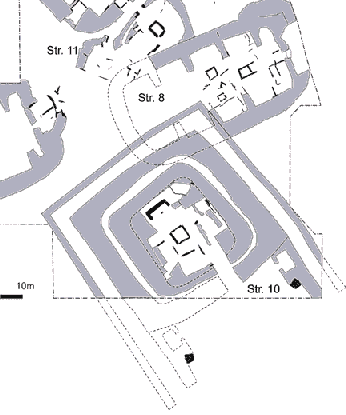 Experts have uncovered
what is being called a Neolithic 'Cathedral'.
The massive building is of a kind never seen before in Britain. It
is 82 ft long and 65ft wide with walls still standing over 3ft high
(proposed at 10ft originally),
which were up to 16ft thick and surround a cross-shaped inner sanctum. The building was surrounded
by a paved outer passage, which experts believe may have formed a
labyrinth that would have led people to the heart of the building.
(1) Experts have uncovered
what is being called a Neolithic 'Cathedral'.
The massive building is of a kind never seen before in Britain. It
is 82 ft long and 65ft wide with walls still standing over 3ft high
(proposed at 10ft originally),
which were up to 16ft thick and surround a cross-shaped inner sanctum. The building was surrounded
by a paved outer passage, which experts believe may have formed a
labyrinth that would have led people to the heart of the building.
(1)
Two stone slabs bearing red, yellow and orange
pigment are the first evidence of painted walls ever found in the
UK. The paint will be subjected to laboratory analysis to determine
its composition. It is probably based upon hematite or limonite, two
iron ores found in the region. These would have been finely ground
and mixed with animal fat, milk or eggs to create pigments.
Since this is the first finding of its kind, it is not known if
walls were commonly painted or if this was reserved for ceremonial
structures such as the �cathedral� at Ness of Brodgar where the
discovery was made. There is speculation that decorative markings
carved into the sandstone of the interior walls may also have been
enhanced with colour. (4)
Other Interesting Discoveries Include:
Red sandstone
uprights, the nearest source of which is 12 miles away.
(3)

This
piece of stone was found in Building 12. It shows a
triangle, bottom left, and two squares - suggestive of
geometry.
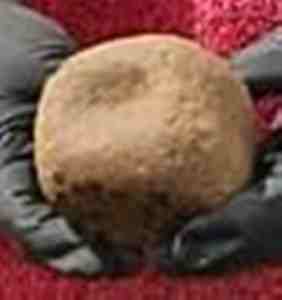
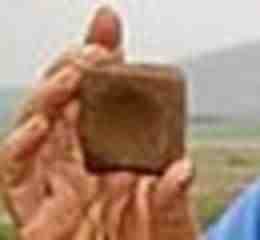
These two
stone cubes were found, they measure about 5 and 8 cm cubed. The
small one is a regular sharp edged clear cut cube.
(Photo Credits:
goudryan.com)
.....Archaeology on the site continues this year: Watch this space.....
(Ring of
Brodgar) (Stenness)
(Maes Howe)
(Orkneys
Homepage)
(Other Scottish Sites)
|
 The Ness of Brodgar has been revealed as an
integral part of the Brodgar/Stennes Complex, being sited directly
between the two sites, and composing a complex of around 100
buildings and a vast wall, 100m long and 4m wide, traversing the
width of the peninsula and potentially surrounding the site
turning it into the equivalent of a a temple precinct.
(2) This site has greatly
helped to unravel the prehistoric perspective of the area. The
site It was occupied from 3,500 BC for over a thousand years,
showing stark similarities with Stonehenge. The archaeologist,
Mike Pearson who conducted the recent digs at Stonehenge has
suggested that the two sites may have similarities in function,
representing the symbolic boundary between the land of the
living and the land of the dead.
The Ness of Brodgar has been revealed as an
integral part of the Brodgar/Stennes Complex, being sited directly
between the two sites, and composing a complex of around 100
buildings and a vast wall, 100m long and 4m wide, traversing the
width of the peninsula and potentially surrounding the site
turning it into the equivalent of a a temple precinct.
(2) This site has greatly
helped to unravel the prehistoric perspective of the area. The
site It was occupied from 3,500 BC for over a thousand years,
showing stark similarities with Stonehenge. The archaeologist,
Mike Pearson who conducted the recent digs at Stonehenge has
suggested that the two sites may have similarities in function,
representing the symbolic boundary between the land of the
living and the land of the dead.

 Experts have uncovered
what is being called a Neolithic 'Cathedral'.
The massive building is of a kind never seen before in Britain. It
is 82 ft long and 65ft wide with walls still standing over 3ft high
(proposed at 10ft originally),
which were up to 16ft thick and surround a cross-shaped inner sanctum. The building was surrounded
by a paved outer passage, which experts believe may have formed a
labyrinth that would have led people to the heart of the building.
(1)
Experts have uncovered
what is being called a Neolithic 'Cathedral'.
The massive building is of a kind never seen before in Britain. It
is 82 ft long and 65ft wide with walls still standing over 3ft high
(proposed at 10ft originally),
which were up to 16ft thick and surround a cross-shaped inner sanctum. The building was surrounded
by a paved outer passage, which experts believe may have formed a
labyrinth that would have led people to the heart of the building.
(1)

